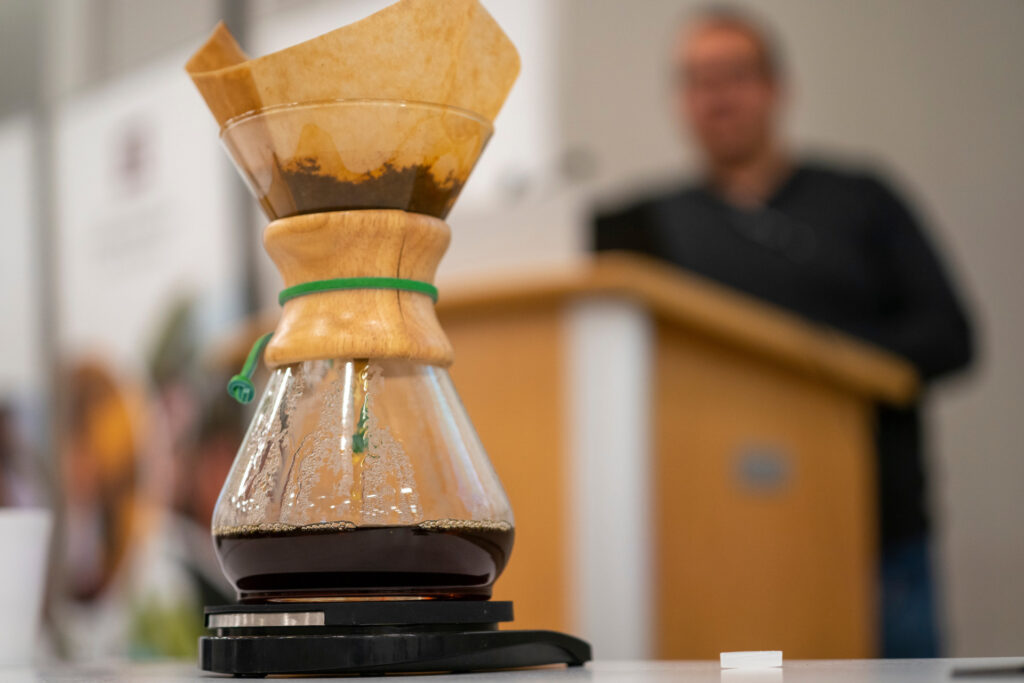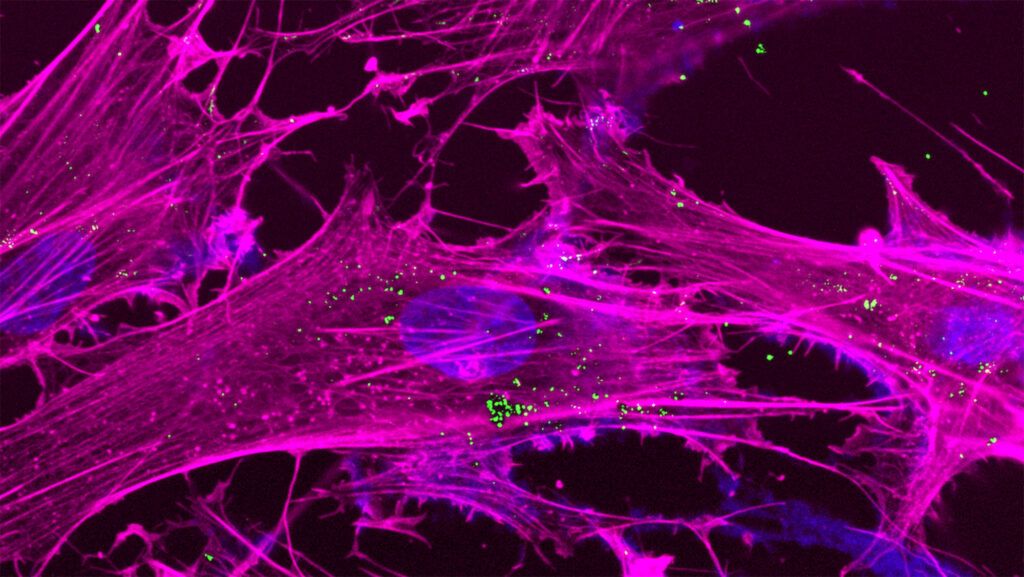Top coffee questions answered by a Texas A&M AgriLife coffee pro
Center for Coffee Research and Education gives answers and tips from bean to brew
Coffee shops are convenient but can also be expensive. The more you know about coffee and how to make it, the more inspired you may be to try brewing your favorite roast into a perfect cup of joe, espresso, cold brew, cappuccino or latte.
A coffee pro, Eric Brenner, assistant director of the Center for Coffee Research and Education, housed within Texas A&M AgriLife Research’s Norman Borlaug Institute for International Agriculture, provided answers to some of the top questions about the most popular beverage in the world.

Improving coffee for farmers and consumers
Texas A&M AgriLife and the Texas A&M College of Agriculture and Life Sciences have a long history with coffee and coffee farmers, and its influence in the industry continues to grow through the center.
The Center for Coffee Research and Education’s origins are rooted in a program designed to return economic opportunity to war-torn Rwanda two decades ago. Brenner said the center continues to focus on areas of the world where improving production methods and opportunities for farmers translates into improved economic stability.
Brenner carries his coffee expertise to the classroom as well, teaching the Department of Horticultural Sciences course – HORT 450, “Processing Coffee and High-Value Horticultural Crops,” which examines the principles behind coffee and other high value crops, including cultivation, processing, preservation and packaging and marketing strategies.
“At the center, we’re focused on the science of improving coffee, from the production fields to that morning cup,” he said. “The reason we want our students and the public to understand coffee, where it comes from and the processes that go into preparing it for consumption and the various ways to consume it, isn’t because we want to create coffee snobs. Our purpose it to help coffee farmers and to bring good coffee to the world.”
Below Brenner answers some questions and gives some tips regarding how coffee drinkers can improve the coffee-making experience.
What is the difference between ‘specialty coffees’ and common commercial coffees?
From my perspective, I see similarities between coffee and wine when it relates to comparing commercial coffee to specialty coffee. For example, box wine can work, but an exceptional wine vintage can be an experience a world apart. And like wine grapes, coffee bean varieties, the microclimate they are grown in, including the soil and elevation, and the grower all have an incredible influence on coffee’s flavor notes and terroir.
What is the difference between Arabica and robusta coffee?

There are hundreds of coffee species in the wild. Commercially, robusta and Arabica are the most common in the market.
While they are two of the most popular coffee beans grown, there are many varieties of those two species. The taste difference between the two is very clear. Robusta is a little harsher, whereas Arabica is usually sweeter. Robusta is grown at a lower elevation, is more resilitent and yields much more than Arabica coffee plants. It also has twice as much caffeine as Arabica.
You can definitely tell the difference in the taste, but a lot of commercial coffees blend robusta and Arabica because robusta is less expensive. From my perspective, Arabica is a better option, but there are many coffee varieties to explore. You can go online and order all sorts of specialty coffees from around the world that will tell you the variety, the farmer, the elevation it was grown at and the flavor notes to expect.
How can I make a great cup of coffee?
Great coffee starts with good quality coffee. Personally, I prefer Arabica coffee over robusta and other blends. There is an effort to improve robusta quality, but we are still experimenting with different processing methods that could accomplish that.
Secondly, water would be the most important component, almost as important as good coffee, since 98% of your coffee is water. The Specialty Coffee Association has created the Water Brewing Standards. Your water should be clean, fresh and odor-free. No chlorine should be present. Excess substances and total dissolved solids in water hinder the dissolution of coffee bean components during brewing, impacting the overall flavor extraction process.
I recommend filtered water or buying distilled water and adding the right minerals. We use Third Wave Water mineral packets that will bring out the flavor notes from the beans.
Then you want to focus on your water-to-coffee grounds ratio. Look at it as if it were a recipe. Basically, the amount of ground coffee you need is based on the amount of water you will use to brew your coffee. For our recipe, we use a scale to weigh our coffee and then use the ratio conversions to measure the exact amount of coffee and water needed.
It sounds complicated, but it really is not. In essence, for every gram of coffee, we will use between 13 grams of water up to 20 grams of water. A great middle of the road measure would be a 1-15 ratio. For example, if you have 30 grams, or about 5.5 tablespoons, of coffee, 30 grams times 15 would yield around 450 grams of water, which makes close to 4 cups of coffee. For those without a scale, using tablespoons and ounces to measure coffee or water, follow the ratio of 1:4. Use 1 tablespoon of coffee for every 4 ounces of water.

What is the difference between pre-ground coffee and grinding your own?
The main difference is freshness and how long your coffee lasts. But like I said, the grind can also influence how the various brewing methods draw the flavor notes out of the grounds. Investing in a grinder that you can adjust the grind size is a good, inexpensive way to start exploring the options out there. Coffee stays fresh in a bag around a month if the coffee is whole bean and about two weeks if the coffee is already ground. When you look at the bag, look for the roasting date and not the expiration date.
The grinding size is important based on the type of brewing method you are using. Espresso uses a very fine grind compared to French press, which uses a very course grind. Grind size is very important because using the wrong grind size could create an underdeveloped, or watery, cup, or an over-extracted, or bitter, cup. A good rule of thumb is a fine grind is like sand, medium is like table salt and coarse is more like rock salt.
How can I make my own iced coffee?
Iced coffee is brewed using hot water and traditional coffee brewing methods like drip brewing or pour-over. Once brewed, it is cooled down and poured over ice to chill. However, you should account for the ice melt when calculating your water to coffee ratio.
Coldbrew coffee is made by steeping coarsely ground coffee beans in cold water for an extended period, often 12-24 hours. It is brewed at room temperature or in the refrigerator, which eliminates the need for hot water.
The flavor profiles are very different. Iced coffee tends to have a flavor profile similar to regular hot coffee, but it is diluted by the melting ice. It can sometimes be slightly more acidic due to the hot brewing process. Cold brew coffee could be perceived as smoother, maybe less acidic in taste. The long, slow steeping process results in a coffee concentrate that is often diluted with water or milk before drinking.

How much caffeine is in coffee?
The main determinant of caffeine in your coffee is not the roast, but the species of coffee. Robusta has almost twice as much caffeine as Arabica.
On average, a single Arabica coffee bean contains 1.9 milligrams of caffeine whereas a single robusta bean has 2.9 milligrams of caffeine. One cup of brewed coffee contains 70-140 milligrams of caffeine. Contrary to people’s perception, espresso has a lower amount of caffeine than a regular cup of coffee. A 1-1.75 ounce shot of espresso generally contains about 63 milligrams of caffeine.
By comparison, an 8-ounce cup of tea has 26 milligrams of caffeine while a 12-ounce Coca-Cola has 34 milligrams and a 12-ounce Red Bull energy drink has 111 milligrams of caffeine.
Is coffee bad for you?
Black coffee without all the artificial additives, sugars, syrups, etcetera, is really good for you. There have been numerous studies that show the health properties of coffee, including antioxidants and anti-inflammatory qualities. Studies have shown coffee can reduce the incidence of certain diseases like Type 2 diabetes and stroke.
It has been linked to a lower risk of liver disease. It is great for your cardiovascular health, can help enhance your mood, and can even increase your longevity. However, like anything else, it should be consumed in moderation.





